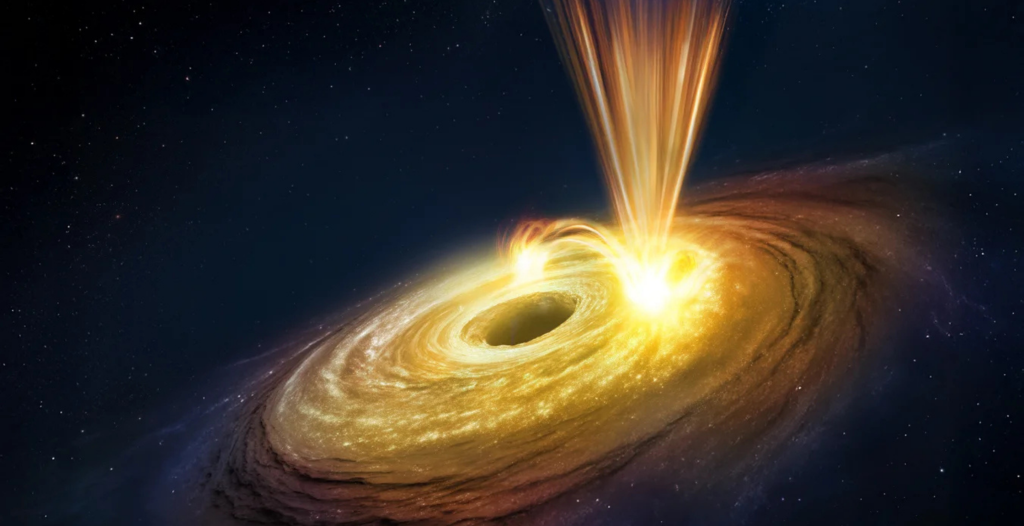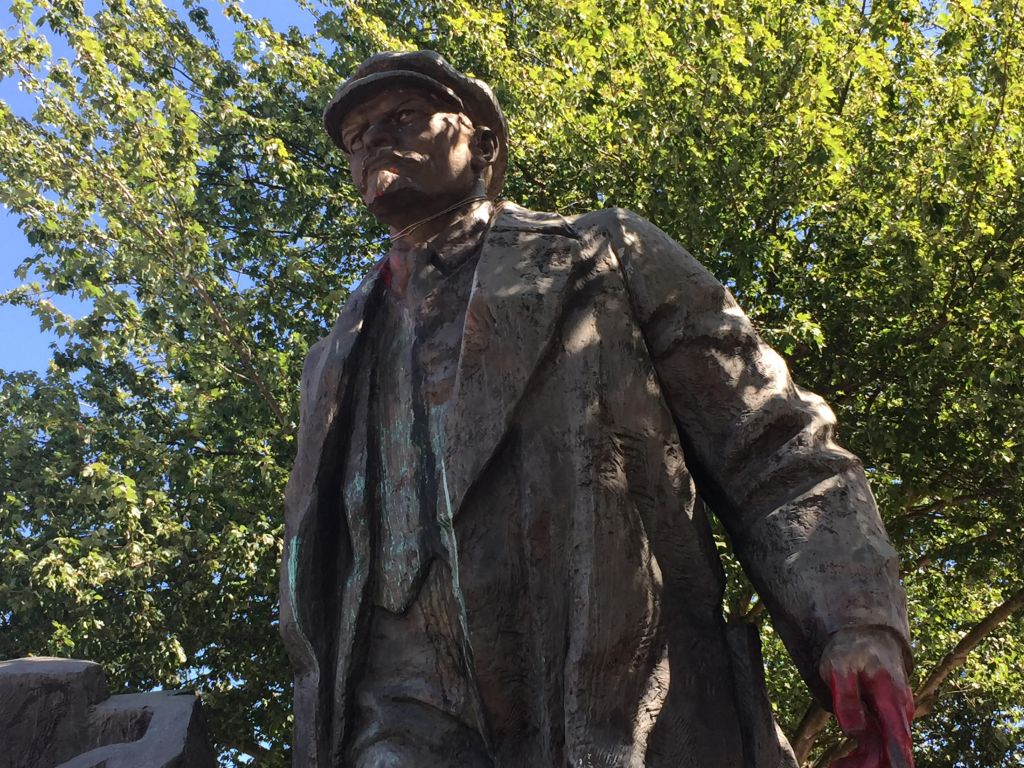The shaft of the flesh-colored dildo atop Vladimir Lenin’s head pointed upward at a slight angle, giving the Russian revolutionary the appearance of a grumpy, hyper-sexualized unicorn.
Lenin has been defaced before. Standing on a prominent corner off the main drag of the Seattle neighborhood of Fremont, the hulking bronze sculpture has donned a frilly tutu during gay pride and is annually dolled up for Halloween. Anonymous vandals have painted his hands bloodred so many times that the Fremont Art Council has given up trying to powerwash the stain clean.
Videos by VICE
The dildo, the rubber scrotum of which was superglued flat onto the top of Lenin’s dome on a recent August night, was just the latest instance—one that felt especially timely.
Lenin’s role in the ongoing national dialogue about the place of historic statues in modern life has been as predictable as it is tiresome. In the wake of Charlottesville—where plans to remove a tribute to Confederate general Robert E. Lee beget a white supremacist rally that turned violent and claimed a counter-protester’s life—it was probably only a matter of time before somebody moved on Vladimir.
A right-wing media personality and a scant gathering of like-minded protesters rallied beneath the statue’s base earlier this month in a clear attempt to shift the debate from arguments over monuments commemorating and celebrating the Confederacy—a kind of All Statues Matter moment. That might have been the end of the local “controversy,” but days later, embattled Seattle mayor Ed Murray called for the removal of Lenin, as well as the memorial for Confederate soldiers elsewhere in a city a few days later. (Both Lenin and the memorial are on private property.)
Headlines practically wrote themselves: Pacific Northwest Socialists Venerate Commie Strongman While Condemning Civil War Heroes.
Scratch even a millimeter beneath the surface, though, and any equivalence between this statue and the Confederate statues across America is revealed as utterly false. Unlike those monuments, Seattle’s Lenin isn’t meant to celebrate a bygone era. The story behind it is much stranger than that.
Lewis Carpenter is the man who brought the statue to Seattle. Those who knew him well say he was no Marxist. Instead, he was a wannabe restaurateur with dreams of one day opening up an Eastern European joint in his hometown.
The Seattleite spent a year teaching English in Czechoslovakia in the early 1990s. While in Europe, Carpenter had taken to hosting goulash potlucks with a group of Slovak immigrant friends, and he hoped to turn that into a full-time gig. That was his first thought when he discovered the condemned Lenin statue in a scrapyard near the school where he taught. He had no particular fondness for the former Soviet leader. Instead, the statue looked like a business opportunity. What better way to call attention to his new restaurant than by parking a glowering, 16-foot-tall bronze advertisement right out front?
Carpenter made a deal with the Poprad city council to buy the statue. He was so confident in the worthiness of his investment that he mortgaged his house to help cover the shipping costs back home.
“It wasn’t to celebrate communism,” his nephew Mike told me recently. “The ultimate anti-socialism is capitalism, right? He did it to make a buck.”
Carpenter was renowned by both family and friends as a prodigious prankster, and in the origins of the Lenin statue, he recognized a kindred spirit. Bulgarian sculptor Emil Venkov had won a state-sponsored contest to craft the statue but was privately conflicted on Lenin’s legacy. Whereas most tributes cast Lenin as a scholar, Venkov’s subtle act of subversion portrayed him more as an aggressor, a heavy scowl permanently creasing his face.
Carpenter died in a car accident a few years after Vladimir completed his long journey from Eastern Europe to the Puget Sound, his grand plans for his future restaurant perishing with him. That could’ve been the end of it, but Peter Bevis, the founder of the Fremont Foundry, agreed to hold the sculpture until a new buyer could be found. (The Carpenters are still waiting.)
Vladimir was unveiled at the corner of Evanston Avenue North and North 34th Street in June 1995—catty-corner from another piece of Cold War kitsch, a repurposed rocket fuselage. Though he was later moved two blocks north, the statue has leaned forward in repose over the neighborhood ever since.
That it’s this neighborhood, and not another, makes a big difference when discussing whether the statue should be removed. Fremont’s unofficial motto is De Libertas Quirkas, roughly translated from Latin as the “Freedom to Be Peculiar.” The neighborhood hosts the city’s Summer Solstice festival, which includes an annual naked bicycle ride, and numerous art instillations dot its sidewalks. Up the hill from Lenin, the Fremont Troll devours a Volkswagen beneath the Aurora Bridge. Across the street is the “Center of the Universe” signpost guiding the way to neon Rapunzel (one block), Taiwan (8,753 kilometers), and the Milky Way (69 light years). Similarly cast in bronze is a tribute to J.P. Patches and his sidekick Gertrude, the clown stars of a beloved children’s show that ran on local TV for decades.
That’s not to say the Lenin statue has been entirely without controversy. Before he even arrived, a local radio station hosted an open mic in the empty lot where the statue would one day stand to get a feel for Fremont’s general reaction. There were a handful of impassioned naysayers, but on the whole, the neighborhood of artists recognized Lenin for what he was: an art instillation far more than a glorification.
“I like to think irony is alive and well in Fremont and that we can be a role model for irony for the rest of the country,” said Barbara Luecke of the neighborhood’s Art Council.
Of the ongoing national debate over monuments and their greater, symbolic significance, she added, “We’re all involved in a messy expanding consciousness exercise. I think we could we could all use a bit of a lightening of spirit.”
Kathleen Braden, a retired professor of geography at Seattle Pacific University, has followed the events of the last few weeks with interest and expertise. She has been traveling to the former Soviet Union for decades, making at least 20 trips through the years. She’s taken many a visitor from that part of the world past the Lenin statue and says their reactions have been almost unanimous—a smirk and a snide joke about how he’d ended up in front of a Taco Del Mar chain restaurant.
“When you look up the origin of the word ‘monument,’ it doesn’t mean celebrate,” Braden said. “It means to remember. To remove the reminder, to me, is just erasing, and it takes away the opportunity to learn.”
There is a legitimate, deep conversation to be had about the place of Confederate imagery in the 21st-century United States, and by extension those of the Founding Fathers, and the European explorers. The country seems to be grappling with who its monuments honor, and why.
When it comes to Seattle’s Lenin in particular, though, any question of whether he is being improperly glorified can be answered with a simple gesture toward the appendage currently pointing out of the top of his head.
Matt Pentz is a Seattle-based freelance writer whose work has also appeared in the New York Times, the Guardian, and ESPN. You can follow him on Twitter.
More
From VICE
-

Photo: GK Hart/Vikki Hart / Getty Images -

Photo: ESA -

Screenshot: Jarrad Nolan / ATSB

